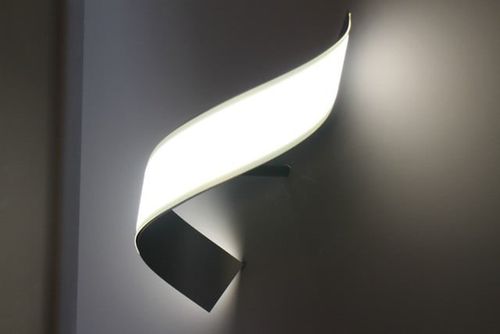In the field of OLED lighting, its form has long been appreciated more than its function. A new study by Chinese researchers showcases a color-tunable OLED architecture that not only expands the boundaries of spectral control but also reimagines how OLEDs can meet the needs of circadian rhythm lighting, specialized architectural designs, or horticultural applications.
Instead of relying on a separate white light component, the team achieved real-time color tuning from warm to cool tones by adjusting the voltage, resulting in smooth spectral transitions across a range up to 11,411 Kelvin. But the deeper significance lies behind these numbers. These devices show signs of overcoming some of the material and reliability limitations that have long hindered the application of OLEDs in general lighting: more balanced exciton recombination, lower operating voltages, and potential pathways to more durable and flexible lighting elements.
OLED lighting has yet to reclaim mainstream status from LEDs—but this research repositions it as a reliable tool, albeit a niche one, suitable for applications requiring visual softness, spectral adaptability, and design-priority form factors.

This article may reignite interest in some specialized fields regarding this technology, once hailed as the next major breakthrough in general lighting—though it remains unclear whether this represents a technological revival or merely a bright footnote.
Color Adjustability and Higher Efficiency This new research from a team at Jilin University has unveiled an OLED capable of dynamically adjusting its correlated color temperature (CCT), ranging from a warm 3451 K to a cool 8073 K. This makes it ideal for matching daylight cycles or supporting indoor lighting that aligns with human circadian rhythms. One configuration even achieves a CCT range of 11411 K, one of the widest reported CCT ranges for OLEDs to date.
These devices employ a dual-emitting-layer structure separated by a carefully designed spacer material, enabling precise movement of the exciton recombination region. This allows the OLED to emit more blue or orange light depending on the applied voltage. This technological breakthrough directly addresses the need for tunable white lighting—which is rapidly gaining traction in commercial interior design, education, and healthcare.
An orange-doped OLED device achieved a peak power efficiency of 106 lm/W—a significant improvement for OLED devices, but still below the typical levels for current high-performance LED packages. It's important to note that this measurement was taken under ideal laboratory conditions for a monochrome OLED element, not a white light element tested at the system level.
Why OLED Lighting Has Never Been Widespread
To understand the significance of these figures, it's important to remember the development history of OLED lighting—and the difficulties it has encountered.
In the early 2010s, OLED panels were touted as the future of general lighting: ultra-thin, diffused, glare-free, and aesthetically pleasing. However, they have consistently failed to achieve commercial success. According to multiple assessments by the U.S. Department of Energy (DOE), the eventual marginalization of OLED lighting is the result of a combination of factors:
Efficiency Gap: While OLEDs looked promising in theory, their actual performance fell short. Tests at DOE laboratories showed that OLED luminaires typically only achieve 23-45 lm/W, while comparable LED luminaires often exceed 100 lm/W. Even today, standard LEDs remain far more efficient than OLEDs.
High cost and low yield: The U.S. Department of Energy predicted that OLED panel costs would need to be controlled to around $100 per square meter to compete with LED panels. However, due to complex manufacturing processes and packaging challenges, the actual cost is much higher.

Durability and reliability issues: OLEDs are susceptible to moisture and oxygen, leading to premature dark spots and short circuits. Standard LED drivers are typically used, but these are incompatible with the characteristics of OLEDs, resulting in further efficiency reduction and flickering problems.
Lack of standards and ecosystem: Due to the lack of interchangeable components, standardized drivers, or plug-and-play connectors, OLEDs are risky for designers and costly for integrators.
Meanwhile, LED technology is rapidly advancing. Side-emitting LED panels are finally aesthetically comparable to OLEDs and surpass them in almost all technical and economic metrics.
Is this just a niche movement, not a revolution?
So, what does this new research mean for the future of OLEDs? The technological progress is real. The performance levels exhibited by lab-manufactured devices were once the theoretical goals of OLED lighting proponents. However, a lab is not a factory, and benchtop testing performance does not equate to market-ready solutions.
Industry adoption requires substantial demand in specific application scenarios. Furthermore, a mature supply chain, cost reduction, and reliable lifetime data are needed—all of which are currently lacking. Previous analysis by the U.S. Department of Energy indicated that even well-structured OLEDs experience a sharp decline in lifetime when operating at high brightness. Moreover, unlike LEDs, OLEDs currently lack a standardized lifetime testing system similar to LM-80.
Nevertheless, OLEDs still have a very narrow but highly promising path for professional development in modern lighting applications—especially in applications where visual softness, design integration, and adjustability are more important than simple lumen/watt economics. Designers still value OLEDs' ability to provide glare-free, visually rich lighting in an almost sculpturally thin form factor.

